Need assistance in calculating constant growth rate/Long term growth rate =g of Valuation of AirThread Connections Case study
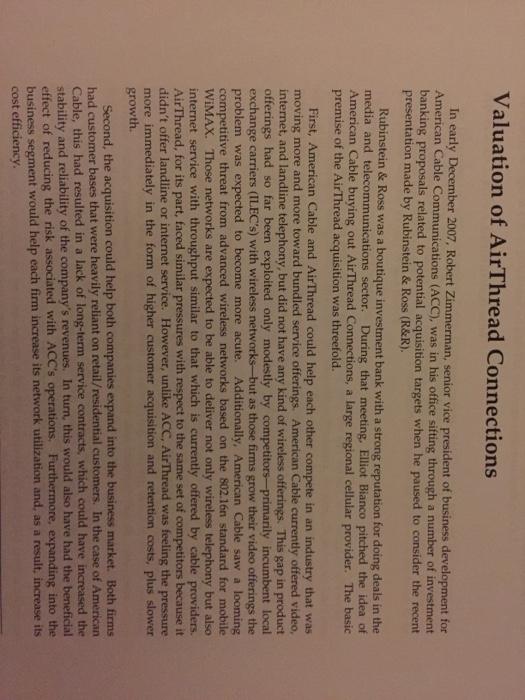

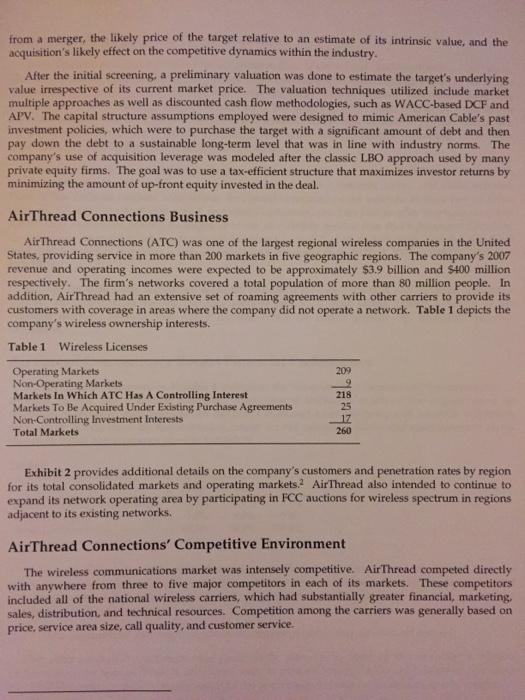
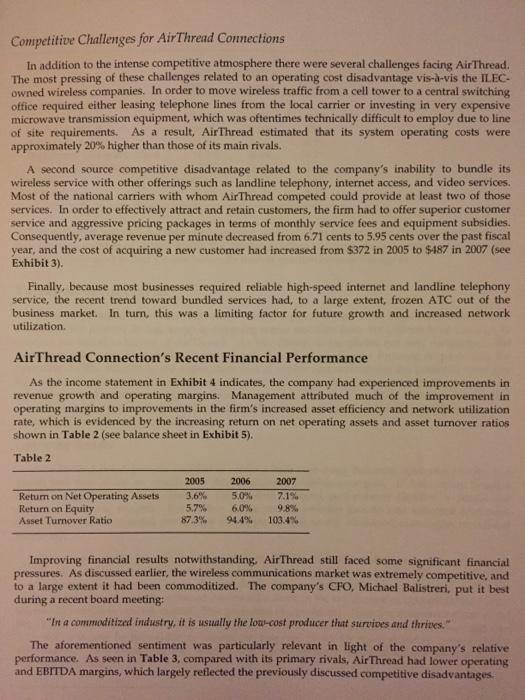
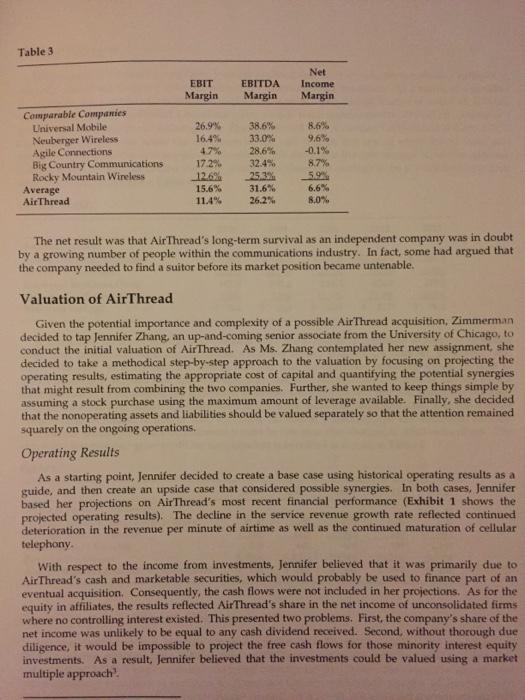
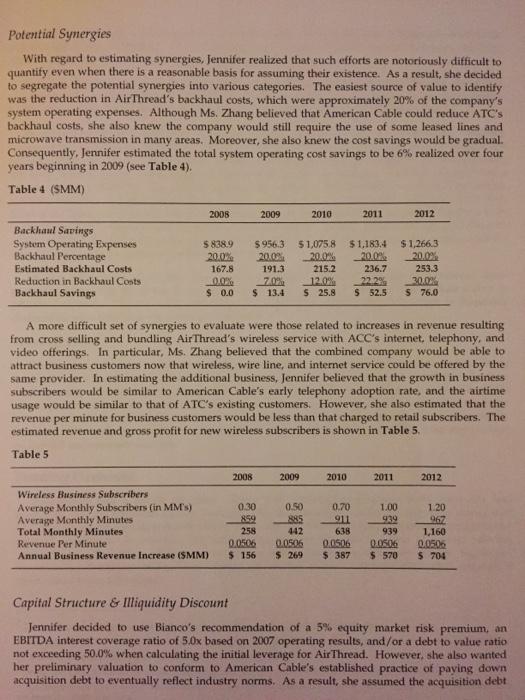
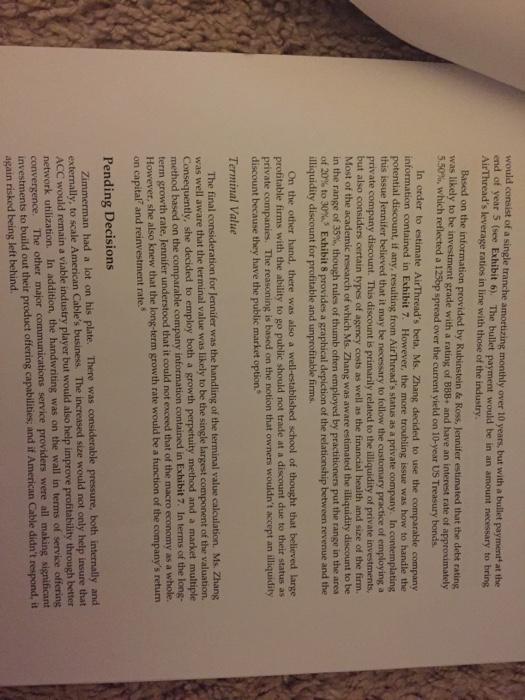

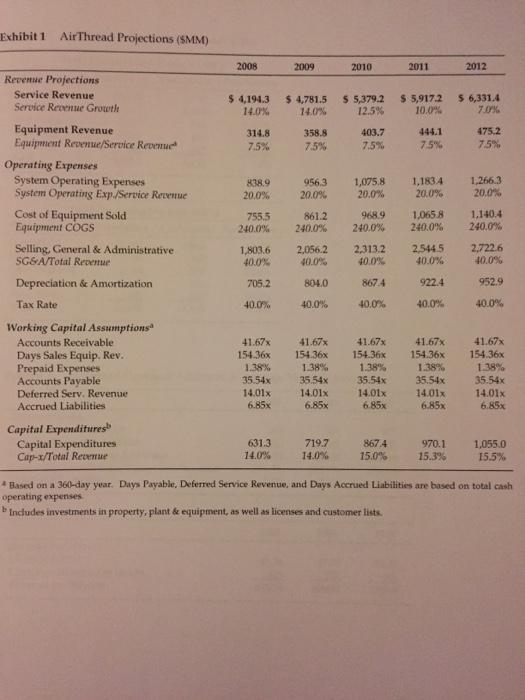
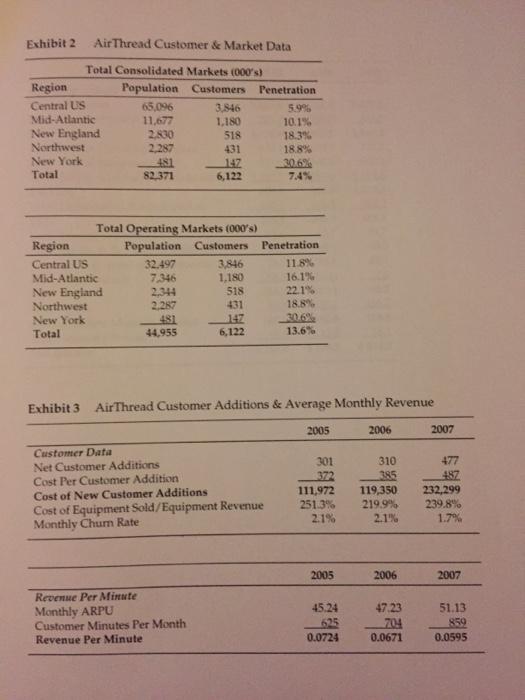
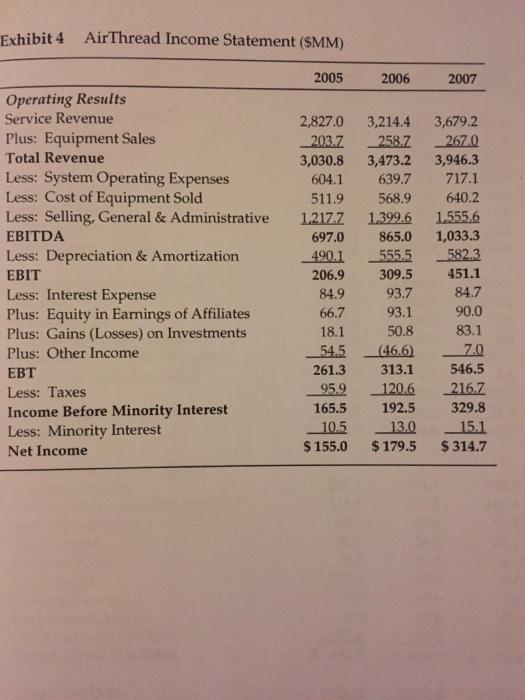
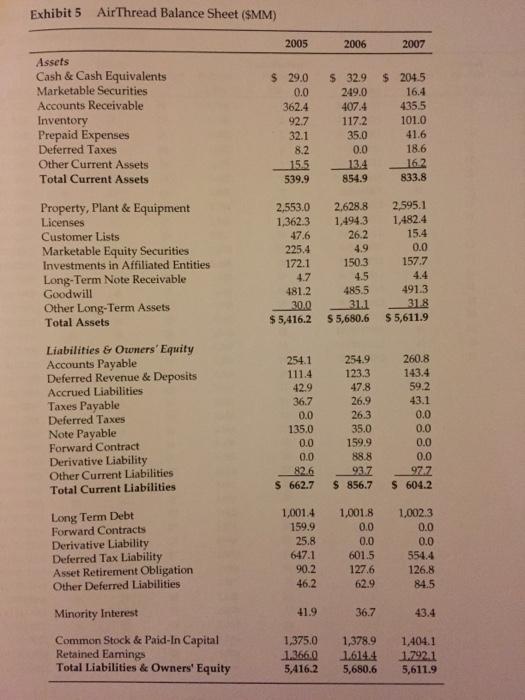

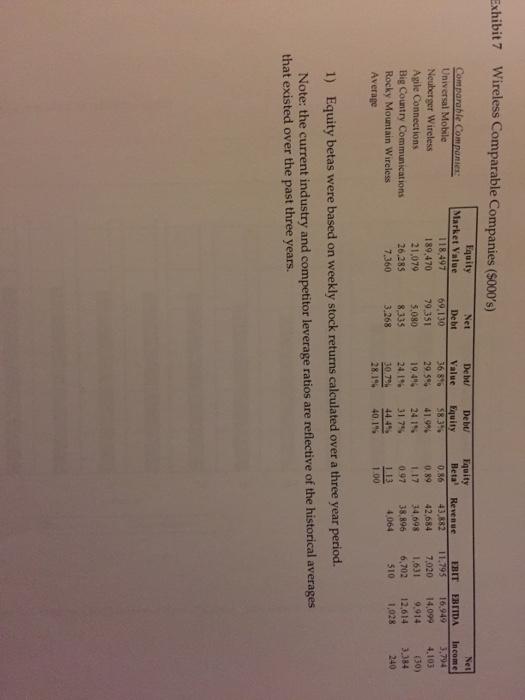
Valuation of AirThread Connections In early December 2007, Robert Zimmerman, senior vice president of business development for American Cable Communications (ACC), was in his office sifting through a number of investment banking proposals related to potential acquisition targets when he paused to consider the recent presentation made by Rubinstein & Ross (R&R). Rubinstein & Ross was a boutique investment bank with a strong reputation for doing deals in the media and telecommunications sector. During that meeting, Elliot Bianco pitched the idea of American Cable buying out AirThread Connections, a large regional cellular provider. The basic premise of the AirThread acquisition was threefold. First, American Cable and AirThread could help each other compete in an industry that was moving more and more toward bundled service offerings. American Cable currently offered video internet and landline telephony, but did not have any kind of wireless offerings. This gap in product offerings had so far been exploited only modestly by competitors-primarily incumbent local exchange carriers (ILEC's) with wireless networks--but as those firms grow their video offerings the problem was expected to become more acute. Additionally. American Cable saw a looming competitive threat from advanced wireless networks based on the 802.16n standard for mobile WiMAX. Those networks are expected to be able to deliver not only wireless telephony but also internet service with throughput similar to that which is currently offered by cable providers. Air Thread, for its part, faced similar pressures with respect to the same set of competitors because it didn't offer landline or internet service. However, unlike ACC, Air Thread was feeling the pressure more immediately in the form of higher customer acquisition and retention costs, plus slower growth Second, the acquisition could help both companies expand into the business market. Both firms had customer bases that were heavily reliant on retail/residential customers. In the case of American Cable, this had resulted in a lack of long-term service contracts, which could have increased the stability and reliability of the company's revenues. In turn, this would also have had the beneficial effect of reducing the risk associated with ACC's operations. Furthermore, expanding into the business segment would help each firm increase its network utilization and, as a result, increase its cost efficiency Third, American Cable was in a unique position to add value to AirThread's operations. AirThread had a cost disadvantage relative to its main wireless competitors owned by ILECS. A large portion of wireless network operating costs related to moving traffic from cell towers to central switching offices using either landlines leased from competitors or technically cumbersome microwave equipment. A preliminary study by Rubinstein & Ross estimated that use of American Cable's fiber lines could have saved AirThread more than 20% in backhaul costs. In addition to the strategic fit, R&R believed that it could obtain a significant amount of debt financing for an Air Thread acquisition Bianco was confident that the high quality of AirThread's network assets, its valuable wireless spectrum licenses, and its steady cash flow would merita debt to value ratio as high as 45% to 50% based on EBITDA coverage ratios exceeding 5.0x.! American Cable Communications In December of 2007, American Cable Communications (ACC) was one of the largest cable operators in the United States. The company's cable systems passed roughly 48.5 million homes and served approximately 24.1 million video subscribers, 13.2 million high-speed internet subscribers, and 4.6 million landline telephony subscribers. Consolidated revenue for 2007 was expected to be $30.9 billion with net income of $2.6 billion. Overview of Cable Industry Dynamics The cable industry had been rapidly transforming over the last decade as a result of advances in technology, changes in regulation, and shifts in competitive dynamics. In turn, these forces had been driving large investments in network infrastructure that require commensurate increases in the customer base to effectively utilize the new capacity. It was this need to acquire economies of scale and scope that led American Cable's executives to believe that only a handful of very large network providers would survive into the future. The smaller companies would eventually be weeded out through industry consolidation. As a result, American Cable became an aggressive acquirer. American Cable's Business Development Group American Cable's business development group has been tasked with the primary goal of increasing the company's customer base as a means to fuel both top line growth and network utilization. From 1999 through 2005, ACC's business development group spearheaded more than $15.0 billion of acquisitions and, as a result, the company believed it had developed a strong corporate finance team with significant acumen in identifying, valuing, structuring, and executing corporate control transactions. In addition, the company also believed that its experience as an acquirer had allowed it to develop unique operational know-how in the area of merger integration Furthermore, the company believed that its core competency as an acquirer would continue to play a fundamental role in its future success. With the rapidly increasing costs of acquiring new customers and the high penetration rates in video and high speed internet, the group surmised that the only way to achieve meaningful customer growth would be through additional acquisitions. American Cable's acquisition process began with the screening of potential communications service providers that operate in territories adjacent to, or within the firm's existing regions. Next, a basic investment thesis was developed that outlined the acquisition benefits in terms of the strategic fit of a target company's assets and operations with those of American Cable, the potential synergies from a merger, the likely price of the target relative to an estimate of its intrinsic value, and the acquisition's likely effect on the competitive dynamics within the industry. After the initial screening, a preliminary valuation was done to estimate the target's underlying value irrespective of its current market price. The valuation techniques utilized include market multiple approaches as well as discounted cash flow methodologies, such as WACC-based DCF and APV. The capital structure assumptions employed were designed to mimic American Cable's past investment policies, which were to purchase the target with a significant amount of debt and then pay down the debt to a sustainable long-term level that was in line with industry norms. The company's use of acquisition leverage was modeled after the classic LBO approach used by many private equity firms. The goal was to use a tax-efficient structure that maximizes investor returns by minimizing the amount of up-front equity invested in the deal. AirThread Connections Business AirThread Connections (ATC) was one of the largest regional wireless companies in the United States, providing service in more than 200 markets in five geographic regions. The company's 2007 revenue and operating incomes were expected to be approximately $3.9 billion and $400 million respectively. The firm's networks covered a total population of more than 80 million people. In addition, AirThread had an extensive set of roaming agreements with other carriers to provide its customers with coverage in areas where the company did not operate a network. Table 1 depicts the company's wireless ownership interests. Table 1 Wireless Licenses Operating Markets 209 Non-Operating Markets Markets In Which ATC Has A Controlling Interest Markets To Be Acquired Under Existing Purchase Agreements Non-Controlling Investment Interests 17 Total Markets 260 218 25 Exhibit 2 provides additional details on the company's customers and penetration rates by region for its total consolidated markets and operating markets. AirThread also intended to continue to expand its network operating area by participating in FCC auctions for wireless spectrum in regions adjacent to its existing networks. AirThread Connections' Competitive Environment The wireless communications market was intensely competitive. AirThread competed directly with anywhere from three to five major competitors in each of its markets. These competitors included all of the national wireless carriers, which had substantially greater financial marketing, sales, distribution, and technical resources. Competition among the carriers was generally based on price, service area size, call quality, and customer service Competitive Challenges for AirThread Connections In addition to the intense competitive atmosphere there were several challenges facing AirThread. The most pressing of these challenges related to an operating cost disadvantage vis-a-vis the ILEC- owned wireless companies. In order to move wireless traffic from a cell tower to a central switching office required either leasing telephone lines from the local carrier or investing in very expensive microwave transmission equipment, which was oftentimes technically difficult to employ due to line of site requirements. As a result, AirThread estimated that its system operating costs were approximately 20% higher than those of its main rivals. A second source competitive disadvantage related to the company's inability to bundle its wireless service with other offerings such as landline telephony, internet access, and video services. Most of the national carriers with whom Air Thread competed could provide at least two of those services. In order to effectively attract and retain customers, the firm had to offer superior customer service and aggressive pricing packages in terms of monthly service fees and equipment subsidies. Consequently, average revenue per minute decreased from 6.71 cents to 5.95 cents over the past fiscal year, and the cost of acquiring a new customer had increased from $372 in 2005 to $487 in 2007 (see Exhibit 3). Finally, because most businesses required reliable high-speed internet and landline telephony service, the recent trend toward bundled services had, to a large extent, frozen ATC out of the business market. In turn, this was a limiting factor for future growth and increased network utilization AirThread Connection's Recent Financial Performance As the income statement in Exhibit 4 indicates, the company had experienced improvements in revenue growth and operating margins. Management attributed much of the improvement in operating margins to improvements in the firm's increased asset efficiency and network utilization rate, which is evidenced by the increasing return on net operating assets and asset turnover ratios shown in Table 2 (see balance sheet in Exhibit 5). Table 2 Retum on Net Operating Assets Return on Equity Asset Turnover Ratio 2005 3,6% 5.7% 87.3% 2006 5.0% 6,0% 94.4% 2007 7.1% 9.8% 103.4% Improving financial results notwithstanding, AirThread still faced some significant financial pressures. As discussed earlier, the wireless communications market was extremely competitive and to a large extent it had been commoditized. The company's CFO, Michael Balistreri, put it best during a recent board meeting: "In a commoditized industry, it is usually the low-cost producer that services and thrives. The aforementioned sentiment was particularly relevant in light of the company's relative performance. As seen in Table 3, compared with its primary rivals, Air Thread had lower operating and EBITDA margins, which largely reflected the previously discussed competitive disadvantages. Table 3 EBIT Margin EBITDA Margin Net Income Margin 26.9% 16.49 Comparable Companies Universal Mobile Neuberger Wireless Agile Connections Big Country Communications Rocky Mountain Wireless Average Air Thread 38.6% 33.0% 28.6% 32.4% 253% 31.6% 26.2% 8.6% 9.6% -0.1% 8.7% 5.9 17.2% 12.6% 15.6% 11.4% 8.0% The net result was that AirThread's long-term survival as an independent company was in doubt by a growing number of people within the communications industry. In fact, some had argued that the company needed to find a suitor before its market position became untenable. Valuation of AirThread Given the potential importance and complexity of a possible Air Thread acquisition, Zimmerman decided to tap Jennifer Zhang, an up-and-coming senior associate from the University of Chicago, to conduct the initial valuation of Air Thread. As Ms. Zhang contemplated her new assignment, she decided to take a methodical step-by-step approach to the valuation by focusing on projecting the operating results, estimating the appropriate cost of capital and quantifying the potential synergies that might result from combining the two companies. Further, she wanted to keep things simple by assuming a stock purchase using the maximum amount of leverage available. Finally, she decided that the nonoperating assets and liabilities should be valued separately so that the attention remained squarely on the ongoing operations. Operating Results As a starting point, Jennifer decided to create a base case using historical operating results as a guide, and then create an upside case that considered possible synergies. In both cases, Jennifer based her projections on AirThread's most recent financial performance (Exhibit 1 shows the projected operating results). The decline in the service revenue growth rate reflected continued deterioration in the revenue per minute of airtime as well as the continued maturation of cellular telephony. With respect to the income from investments, Jennifer believed that it was primarily due to AirThread's cash and marketable securities, which would probably be used to finance part of an eventual acquisition. Consequently, the cash flows were not included in her projections. As for the equity in affiliates, the results reflected AirThread's share in the net income of unconsolidated firms where no controlling interest existed. This presented two problems. First, the company's share of the net income was unlikely to be equal to any cash dividend received. Second, without thorough due diligence, it would be impossible to project the free cash flows for those minority interest equity investments. As a result. Jennifer believed that the investments could be valued using a market multiple approach Potential Synergies With regard to estimating synergies, Jennifer realized that such efforts are notoriously difficult to quantity even when there is a reasonable basis for assuming their existence. As a result, she decided to segregate the potential synergies into various categories. The easiest source of value to identify was the reduction in AirThread's backhaul costs, which were approximately 20% of the company's system operating expenses. Although Ms. Zhang believed that American Cable could reduce ATC's backhaul costs, she also knew the company would still require the use of some leased lines and microwave transmission in many areas. Moreover, she also knew the cost savings would be gradual. Consequently, Jennifer estimated the total system operating cost savings to be 6% realized over four years beginning in 2009 (see Table 4). Table 4 (SMM) 2005 2009 2010 2011 2012 Backhaul Savings System Operating Expenses Backhaul Percentage Estimated Backhaul Costs Reduction in Backhaul Costs Backhaul Savings $ 838.9 20.02 167.8 00 $ 0.0 $956.3 120.02 191.3 7.0% $ 13.4 51,075.8 20.07 215.2 12.0% 5 25.8 $1,183.4 20.0 236.7 22.9 $ 52.5 $1,266.3 20.02 253.3 30.0% 576.0 A more difficult set of synergies to evaluate were those related to increases in revenue resulting from cross selling and bundling AirThread's wireless service with ACC's internet, telephony, and video offerings. In particular, Ms. Zhang believed that the combined company would be able to attract business customers now that wireless, wire line, and internet service could be offered by the same provider. In estimating the additional business, Jennifer believed that the growth in business subscribers would be similar to American Cable's early telephony adoption rate, and the airtime usage would be similar to that of ATC's existing customers. However, she also estimated that the revenue per minute for business customers would be less than that charged to retail subscribers. The estimated revenue and gross profit for new wireless subscribers is shown in Table 5. Table 5 2008 2009 2010 2011 2012 Wireless Business Subscribers Average Monthly Subscribers (in MM's) Average Monthly Minutes Total Monthly Minutes Revenue Per Minute Annual Business Revenue Increase (SMM) 0.30 859 258 0.0506 $ 156 0.50 885 442 0.70 911 638 0.0506 $ 387 1.00 939 939 0.0506 $570 1.20 967 1,160 0.0506 $ 704 0.05.06 $ 269 Capital Structure & Illiquidity Discount Jennifer decided to use Bianco's recommendation of a 5% equity market risk premium, an EBITDA interest coverage ratio of 5.0x based on 2007 operating results, and/or a debt to value ratio not exceeding 50.0% when calculating the initial leverage for AirThread. However, she also wanted her preliminary valuation to conform to American Cable's established practice of paying down acquisition debt to eventually reflect industry norms. As a result, she assumed the acquisition debt would consist of a single tranche amortizing monthly over 10 years, but with a bullet payment at the end of year 5 (see Exhibit 6). The bullet payment would be in an amount necessary to bring AirThread's leverage ratios in line with those of the industry. Based on the information provided by Rubinstein & Ross, Jennifer estimated that the debt rating was likely to be investment grade with a rating of BBB+ and have an interest rate of approximately 5.50%, which reflected a 125 bp spread over the current yield on 10-year US Treasury bonds In order to estimate AirThread's beta, Ms. Zhang decided to use the comparable company information contained in Exhibit 7. However, the more troubling issue was how to handle the potential discount, if any, resulting from AirThread's status as a private company. In contemplating this issue Jennifer believed that it may be necessary to follow the customary practice of employing a private company discount. This discount is primarily related to the liquidity of private investments, but also considers certain types of agency costs as well as the financial health and size of the firm. Most of the academic research of which Ms. Zhang was aware estimated the illiquidity discount to be in the range of 35%, though rules of thumb often employed by practitioners put the range in the area of 20% to 30% Exhibit 8 provides a graphical depiction of the relationship between revenue and the illiquidity discount for protitable and unprofitable firms. On the other hand, there was also a well-established school of thought that believed large profitable firms with the ability to go public should not trade at a discount due to their status as private companies. The reasoning is based on the notion that owners wouldn't accept an illiquidity discount because they have the public market option: Terminal Value The final consideration for Jennifer was the handling of the terminal value calculation. Ms. Zhang was well aware that the terminal value was likely to be the single largest component of the valuation. Consequently, she decided to employ both a growth perpetuity method and a market multiple method based on the comparable company information contained in Exhibit 7. In terms of the long- term growth rate, Jennifer understood that it could not exceed that of the macro economy as a whole. However, she also knew that the long-term growth rate would be a function of the company's return on capital and reinvestment rate Pending Decisions Zimmerman had a lot on his plate. There was considerable pressure, both internally and externally, to scale American Cable's business. The increased size would not only help insure that ACC would remain a viable industry player but would also help improve profitability through better network utilization. In addition, the handwriting was on the wall in terms of service offering convergence The other major communications service providers were all making significant investments to build out their product offering capabilities, and if American Cable didn't respond, it again risked being left behind. Of course Zimmerman also knew there were considerable risks whenever large investments, particularly mergers, were involved. He was well aware of several high profile takeovers that ended in either eventual bankruptcy or considerable loss of shareholder value, and overpaying for a target company was one of the quickest ways to achieve disaster. As a result, he was really relying on Zhang to provide a timely concise analysis that would clearly lay out a likely estimate of the intrinsic value of Air Thread's operations and non-operating assets using ACC's investment approach. Exhibit 1 AirThread Projections (SMM) 2008 2009 2010 2011 2012 Reverse Projections Service Revenue $ 4,194.3 $ 4,781.5 $ 5,379.2 $ 5,917.2 $ 6,331.4 Service Rene Grototh 14.0% 14.0% 12.5% 10.0% Equipment Revenue 314.8 358.8 403.7 444.1 475.2 Equipment Revenue/Service Revenue 7.5% 7.5% 7.5% 7.5% 7.5% Operating Expenses System Operating Expenses 838.9 956,3 1,075.8 1,1834 1,266,3 System Operating Exp./Service Revenue 20.0% 20.0% 20.0% 20.0% 20.0% Cost of Equipment Sold 755.5 8612 968.9 1.065.8 1.140.4 Equipment COGS 240.0% 240.0% 240.0% 240.0% 240.0% Selling, General & Administrative 1.803,6 2,056,2 2,313.2 25445 2,722.6 SG&A/Total Rem 40.0% 40.0% 40.0% 40.0% 10.0% Depreciation & Amortization 705.2 804,0 867.4 922.4 952.9 Tax Rate 40.0% 40.0% 40.0% 40.0% 40.0% Working Capital Assumptions Accounts Receivable 41.67% 41.67% 41.67% 41.67% 41.67% Days Sales Equip. Rev. 154.36x 154.36x 154.36x 154.36x 154.36x Prepaid Expenses 1.38% 1.38% 1.38% 1.38% 1.38% Accounts Payable 35.54x 35.54x 35.54x 35.54x 35.54% Deferred Serv. Revenue 14.01% 14.01% 14.01x 14.01x 14.01% Accrued Liabilities 6.85% 6.85% 6.85% 6.85x 6.85% Capital Expenditures Capital Expenditures 631.3 719.7 867.4 970.1 1,055.0 Cap-x/Total Revenue 14.0% 14.0% 15.09% 15.3% 15.5% Based on a 360-day year. Days Payable, Deferred Service Revenue and Days Accrued Liabilities are based on total cash operating expenses Includes investments in property, plant & equipment, as well as licenses and customer lists Exhibit 2 Air Thread Customer & Market Data Total Consolidated Markets 1000's) Region Population Customers Penetration Central Us 65,096 3.846 5.996 Mid-Atlantic 11,677 1,180 10.1% New England 2,830 518 18.3% Northwest 2.287 431 18.8% New York 481 EZ Total 82.371 6,122 7.4% Total Operating Markets (000's) Region Population Customers Penetration Central US 32.497 3.846 11.8% Mid-Atlantic 7.346 1,180 16.1% New England 2.314 518 22.1% Northwest 2.287 431 18.8% New York 431 Total 44,955 6,122 13.6% Exhibit 3 AirThread Customer Additions & Average Monthly Revenue 2005 2006 2007 Customer Data Net Customer Additions Cost Per Customer Addition Cost of New Customer Additions Cost of Equipment Sold/Equipment Revenue Monthly Chum Rate 301 372 111.972 251.3% 2.1% 310 385 119,350 219.9% 2.1% 477 487 232,299 239.8% 1.7% 2005 2006 2007 Recenme Per Minute Monthly ARPU Customer Minutes Per Month Revenue Per Minute 45.24 625 0.0724 47.23 704 0.0671 51.13 859 0.0595 Exhibit 4 AirThread Income Statement (SMM) 2005 2006 2007 Operating Results Service Revenue Plus: Equipment Sales Total Revenue Less: System Operating Expenses Less: Cost of Equipment Sold Less: Selling, General & Administrative EBITDA Less: Depreciation & Amortization EBIT Less: Interest Expense Plus: Equity in Earnings of Affiliates Plus: Gains (Losses) on Investments Plus: Other Income EBT Less: Taxes Income Before Minority Interest Less: Minority Interest Net Income 2,827.0 203.7 3,030.8 604.1 511.9 1.217.7 697.0 _490.1 206.9 84.9 66.7 18.1 54.5 261.3 95.9 165.5 10.5 $ 155.0 3,214.4 258.7 3,473.2 639.7 568.9 1.399.6 865.0 555.5 309.5 93.7 93.1 50.8 (46.6) 313.1 120.6 192.5 13.0 $ 179.5 3,679.2 2670 3,946.3 717.1 640.2 1.555.6 1,033.3 582.3 451.1 84.7 90.0 83.1 7.0 546.5 216.7 329.8 15.1 $314.7 Exhibit 5 AirThread Balance Sheet (SMM) 2005 2006 2007 Assets Cash & Cash Equivalents Marketable Securities Accounts Receivable Inventory Prepaid Expenses Deferred Taxes Other Current Assets Total Current Assets $ 29.0 0.0 362.4 92.7 32.1 8.2 155 539.9 $32.9 249.0 407.4 117.2 35.0 0.0 13.4 854.9 $ 2045 16.4 435.5 101.0 41.6 18.6 16.2 833.8 2.628.8 1,494.3 26.2 2.553.0 1,362.3 47.6 225.4 172.1 4.7 481.2 300 $5,416.2 150.3 4.5 485.5 31.1 S 5,680.6 2.595.1 1,482.4 15.4 0.0 157.7 4.4 491.3 31.8 $ 5,611.9 Property, Plant & Equipment Licenses Customer Lists Marketable Equity Securities Investments in Affiliated Entities Long-Term Note Receivable Goodwill Other Long-Term Assets Total Assets Liabilities & Owners' Equity Accounts Payable Deferred Revenue & Deposits Accrued Liabilities Taxes Payable Deferred Taxes Note Payable Forward Contract Derivative Liability Other Current Liabilities Total Current Liabilities 254.1 111.4 42.9 36.7 0.0 135.0 0.0 0.0 82.6 $ 662.7 254.9 123.3 47.8 26.9 26.3 35.0 159.9 88.8 93.7 $ 856.7 260.8 143.4 59.2 43.1 0.0 0.0 0.0 0.0 977 $ 604.2 Long Term Debt Forward Contracts Derivative Liability Deferred Tax Liability Asset Retirement Obligation Other Deferred Liabilities 1,001.4 159.9 25.8 647.1 90.2 46.2 1,001.8 0.0 0.0 601.5 127.6 62.9 1,002.3 0.0 0.0 554.4 126.8 84.5 41.9 36.7 43.4 Minority Interest Common Stock & Paid-In Capital Retained Eamings Total Liabilities & Owners' Equity 1,375.0 1.366,0 5,416.2 1,378.9 1.614. 5,680,6 1.404.1 1.792.1 5,611.9 Exhibit 6 Debt Repayment Schedule Term Loan Amortization (SMM) Payment 61 Amortization Period Annual Interest 5.50 17 Anal Interes Payment 1 Principal Balance America ed - 1 2 41 2441 Date 1/31/300 2/28/2008 3/1/2008 4/30/2008 5/31/2008 6/30/2008 Principal Balance 37756 24 374 24 710 24 3. 34 34 24 31 41 41 41 41 13 12 13 13 11 35 YE 5 IT Date // 7/21/ W31/2011 /2011 10/31/2011 11/2011 12/31/2011 1/11/2012 1/2 3/31/2012 //2012 w21/2012 2 2 5 AT E 41 81 61 +1 41 5 15 17 17 12 17 17 1 JA to 15 16 16 16 In 15 15 15 41 41 41 43 41 41 41 41 41 41 1 12 11 11 11 11 20 25 25 B//2008 //2020 10/31/2008 11/30/2008 1231/2009 1/31/20 2/28/2009 3/31/2009 4730/2009 5/31/20 AAAAAAARRRRRRRRR 30 11 12 11 342 34 3443 3.418 41 41 41 14 15 th 17 11 10 10 41 41 41 41 N/2012 2 10/31/2013 11/12 12/31/2017 Chet 10 30 0 41 41 41 41 19 20 21 B//2000 /2009 10 15 15 15 LIN 34 12/31/2009 11 41 *1 41 41 14 SI AnnRNAAAAAAAAAAAAAA 14 D 2/31/2010 3/31/2010 4/80 W31/2010 41 14 16 14 41 29 4 41 18 13 13 2. 41 41 13 12 41 Exhibit7 Wireless Comparable Companies (S000's) Equity Net Comparable Companies Market Value Debt Universal Mobile 118.497 69,130 Neuberger Wireless 189,470 79 351 Agile Connections 21.079 5.080 Big Country Communications 26.285 Rocky Mountain Wireless 7.360 3.268 Average Debu Equity 58.3% Debt Value 36.896 29.5% 19,496 24.19 30.794 28.196 Equity Beta 0.86 0.89 1.17 0.97 1.13 1.00 Revenue 43.382 42.684 34 698 38,895 4064 FRIT 11,795 7,020 1,631 6,702 510 EBITDA 16,949 14,099 9914 12,614 1,028 Net Income 3,794 4,103 (30) 3,384 240 8,335 24 15 3175 44.41 40.1% 1) Equity betas were based on weekly stock returns calculated over a three year period. Note: the current industry and competitor leverage ratios are reflective of the historical averages that existed over the past three years. Valuation of AirThread Connections In early December 2007, Robert Zimmerman, senior vice president of business development for American Cable Communications (ACC), was in his office sifting through a number of investment banking proposals related to potential acquisition targets when he paused to consider the recent presentation made by Rubinstein & Ross (R&R). Rubinstein & Ross was a boutique investment bank with a strong reputation for doing deals in the media and telecommunications sector. During that meeting, Elliot Bianco pitched the idea of American Cable buying out AirThread Connections, a large regional cellular provider. The basic premise of the AirThread acquisition was threefold. First, American Cable and AirThread could help each other compete in an industry that was moving more and more toward bundled service offerings. American Cable currently offered video internet and landline telephony, but did not have any kind of wireless offerings. This gap in product offerings had so far been exploited only modestly by competitors-primarily incumbent local exchange carriers (ILEC's) with wireless networks--but as those firms grow their video offerings the problem was expected to become more acute. Additionally. American Cable saw a looming competitive threat from advanced wireless networks based on the 802.16n standard for mobile WiMAX. Those networks are expected to be able to deliver not only wireless telephony but also internet service with throughput similar to that which is currently offered by cable providers. Air Thread, for its part, faced similar pressures with respect to the same set of competitors because it didn't offer landline or internet service. However, unlike ACC, Air Thread was feeling the pressure more immediately in the form of higher customer acquisition and retention costs, plus slower growth Second, the acquisition could help both companies expand into the business market. Both firms had customer bases that were heavily reliant on retail/residential customers. In the case of American Cable, this had resulted in a lack of long-term service contracts, which could have increased the stability and reliability of the company's revenues. In turn, this would also have had the beneficial effect of reducing the risk associated with ACC's operations. Furthermore, expanding into the business segment would help each firm increase its network utilization and, as a result, increase its cost efficiency Third, American Cable was in a unique position to add value to AirThread's operations. AirThread had a cost disadvantage relative to its main wireless competitors owned by ILECS. A large portion of wireless network operating costs related to moving traffic from cell towers to central switching offices using either landlines leased from competitors or technically cumbersome microwave equipment. A preliminary study by Rubinstein & Ross estimated that use of American Cable's fiber lines could have saved AirThread more than 20% in backhaul costs. In addition to the strategic fit, R&R believed that it could obtain a significant amount of debt financing for an Air Thread acquisition Bianco was confident that the high quality of AirThread's network assets, its valuable wireless spectrum licenses, and its steady cash flow would merita debt to value ratio as high as 45% to 50% based on EBITDA coverage ratios exceeding 5.0x.! American Cable Communications In December of 2007, American Cable Communications (ACC) was one of the largest cable operators in the United States. The company's cable systems passed roughly 48.5 million homes and served approximately 24.1 million video subscribers, 13.2 million high-speed internet subscribers, and 4.6 million landline telephony subscribers. Consolidated revenue for 2007 was expected to be $30.9 billion with net income of $2.6 billion. Overview of Cable Industry Dynamics The cable industry had been rapidly transforming over the last decade as a result of advances in technology, changes in regulation, and shifts in competitive dynamics. In turn, these forces had been driving large investments in network infrastructure that require commensurate increases in the customer base to effectively utilize the new capacity. It was this need to acquire economies of scale and scope that led American Cable's executives to believe that only a handful of very large network providers would survive into the future. The smaller companies would eventually be weeded out through industry consolidation. As a result, American Cable became an aggressive acquirer. American Cable's Business Development Group American Cable's business development group has been tasked with the primary goal of increasing the company's customer base as a means to fuel both top line growth and network utilization. From 1999 through 2005, ACC's business development group spearheaded more than $15.0 billion of acquisitions and, as a result, the company believed it had developed a strong corporate finance team with significant acumen in identifying, valuing, structuring, and executing corporate control transactions. In addition, the company also believed that its experience as an acquirer had allowed it to develop unique operational know-how in the area of merger integration Furthermore, the company believed that its core competency as an acquirer would continue to play a fundamental role in its future success. With the rapidly increasing costs of acquiring new customers and the high penetration rates in video and high speed internet, the group surmised that the only way to achieve meaningful customer growth would be through additional acquisitions. American Cable's acquisition process began with the screening of potential communications service providers that operate in territories adjacent to, or within the firm's existing regions. Next, a basic investment thesis was developed that outlined the acquisition benefits in terms of the strategic fit of a target company's assets and operations with those of American Cable, the potential synergies from a merger, the likely price of the target relative to an estimate of its intrinsic value, and the acquisition's likely effect on the competitive dynamics within the industry. After the initial screening, a preliminary valuation was done to estimate the target's underlying value irrespective of its current market price. The valuation techniques utilized include market multiple approaches as well as discounted cash flow methodologies, such as WACC-based DCF and APV. The capital structure assumptions employed were designed to mimic American Cable's past investment policies, which were to purchase the target with a significant amount of debt and then pay down the debt to a sustainable long-term level that was in line with industry norms. The company's use of acquisition leverage was modeled after the classic LBO approach used by many private equity firms. The goal was to use a tax-efficient structure that maximizes investor returns by minimizing the amount of up-front equity invested in the deal. AirThread Connections Business AirThread Connections (ATC) was one of the largest regional wireless companies in the United States, providing service in more than 200 markets in five geographic regions. The company's 2007 revenue and operating incomes were expected to be approximately $3.9 billion and $400 million respectively. The firm's networks covered a total population of more than 80 million people. In addition, AirThread had an extensive set of roaming agreements with other carriers to provide its customers with coverage in areas where the company did not operate a network. Table 1 depicts the company's wireless ownership interests. Table 1 Wireless Licenses Operating Markets 209 Non-Operating Markets Markets In Which ATC Has A Controlling Interest Markets To Be Acquired Under Existing Purchase Agreements Non-Controlling Investment Interests 17 Total Markets 260 218 25 Exhibit 2 provides additional details on the company's customers and penetration rates by region for its total consolidated markets and operating markets. AirThread also intended to continue to expand its network operating area by participating in FCC auctions for wireless spectrum in regions adjacent to its existing networks. AirThread Connections' Competitive Environment The wireless communications market was intensely competitive. AirThread competed directly with anywhere from three to five major competitors in each of its markets. These competitors included all of the national wireless carriers, which had substantially greater financial marketing, sales, distribution, and technical resources. Competition among the carriers was generally based on price, service area size, call quality, and customer service Competitive Challenges for AirThread Connections In addition to the intense competitive atmosphere there were several challenges facing AirThread. The most pressing of these challenges related to an operating cost disadvantage vis-a-vis the ILEC- owned wireless companies. In order to move wireless traffic from a cell tower to a central switching office required either leasing telephone lines from the local carrier or investing in very expensive microwave transmission equipment, which was oftentimes technically difficult to employ due to line of site requirements. As a result, AirThread estimated that its system operating costs were approximately 20% higher than those of its main rivals. A second source competitive disadvantage related to the company's inability to bundle its wireless service with other offerings such as landline telephony, internet access, and video services. Most of the national carriers with whom Air Thread competed could provide at least two of those services. In order to effectively attract and retain customers, the firm had to offer superior customer service and aggressive pricing packages in terms of monthly service fees and equipment subsidies. Consequently, average revenue per minute decreased from 6.71 cents to 5.95 cents over the past fiscal year, and the cost of acquiring a new customer had increased from $372 in 2005 to $487 in 2007 (see Exhibit 3). Finally, because most businesses required reliable high-speed internet and landline telephony service, the recent trend toward bundled services had, to a large extent, frozen ATC out of the business market. In turn, this was a limiting factor for future growth and increased network utilization AirThread Connection's Recent Financial Performance As the income statement in Exhibit 4 indicates, the company had experienced improvements in revenue growth and operating margins. Management attributed much of the improvement in operating margins to improvements in the firm's increased asset efficiency and network utilization rate, which is evidenced by the increasing return on net operating assets and asset turnover ratios shown in Table 2 (see balance sheet in Exhibit 5). Table 2 Retum on Net Operating Assets Return on Equity Asset Turnover Ratio 2005 3,6% 5.7% 87.3% 2006 5.0% 6,0% 94.4% 2007 7.1% 9.8% 103.4% Improving financial results notwithstanding, AirThread still faced some significant financial pressures. As discussed earlier, the wireless communications market was extremely competitive and to a large extent it had been commoditized. The company's CFO, Michael Balistreri, put it best during a recent board meeting: "In a commoditized industry, it is usually the low-cost producer that services and thrives. The aforementioned sentiment was particularly relevant in light of the company's relative performance. As seen in Table 3, compared with its primary rivals, Air Thread had lower operating and EBITDA margins, which largely reflected the previously discussed competitive disadvantages. Table 3 EBIT Margin EBITDA Margin Net Income Margin 26.9% 16.49 Comparable Companies Universal Mobile Neuberger Wireless Agile Connections Big Country Communications Rocky Mountain Wireless Average Air Thread 38.6% 33.0% 28.6% 32.4% 253% 31.6% 26.2% 8.6% 9.6% -0.1% 8.7% 5.9 17.2% 12.6% 15.6% 11.4% 8.0% The net result was that AirThread's long-term survival as an independent company was in doubt by a growing number of people within the communications industry. In fact, some had argued that the company needed to find a suitor before its market position became untenable. Valuation of AirThread Given the potential importance and complexity of a possible Air Thread acquisition, Zimmerman decided to tap Jennifer Zhang, an up-and-coming senior associate from the University of Chicago, to conduct the initial valuation of Air Thread. As Ms. Zhang contemplated her new assignment, she decided to take a methodical step-by-step approach to the valuation by focusing on projecting the operating results, estimating the appropriate cost of capital and quantifying the potential synergies that might result from combining the two companies. Further, she wanted to keep things simple by assuming a stock purchase using the maximum amount of leverage available. Finally, she decided that the nonoperating assets and liabilities should be valued separately so that the attention remained squarely on the ongoing operations. Operating Results As a starting point, Jennifer decided to create a base case using historical operating results as a guide, and then create an upside case that considered possible synergies. In both cases, Jennifer based her projections on AirThread's most recent financial performance (Exhibit 1 shows the projected operating results). The decline in the service revenue growth rate reflected continued deterioration in the revenue per minute of airtime as well as the continued maturation of cellular telephony. With respect to the income from investments, Jennifer believed that it was primarily due to AirThread's cash and marketable securities, which would probably be used to finance part of an eventual acquisition. Consequently, the cash flows were not included in her projections. As for the equity in affiliates, the results reflected AirThread's share in the net income of unconsolidated firms where no controlling interest existed. This presented two problems. First, the company's share of the net income was unlikely to be equal to any cash dividend received. Second, without thorough due diligence, it would be impossible to project the free cash flows for those minority interest equity investments. As a result. Jennifer believed that the investments could be valued using a market multiple approach Potential Synergies With regard to estimating synergies, Jennifer realized that such efforts are notoriously difficult to quantity even when there is a reasonable basis for assuming their existence. As a result, she decided to segregate the potential synergies into various categories. The easiest source of value to identify was the reduction in AirThread's backhaul costs, which were approximately 20% of the company's system operating expenses. Although Ms. Zhang believed that American Cable could reduce ATC's backhaul costs, she also knew the company would still require the use of some leased lines and microwave transmission in many areas. Moreover, she also knew the cost savings would be gradual. Consequently, Jennifer estimated the total system operating cost savings to be 6% realized over four years beginning in 2009 (see Table 4). Table 4 (SMM) 2005 2009 2010 2011 2012 Backhaul Savings System Operating Expenses Backhaul Percentage Estimated Backhaul Costs Reduction in Backhaul Costs Backhaul Savings $ 838.9 20.02 167.8 00 $ 0.0 $956.3 120.02 191.3 7.0% $ 13.4 51,075.8 20.07 215.2 12.0% 5 25.8 $1,183.4 20.0 236.7 22.9 $ 52.5 $1,266.3 20.02 253.3 30.0% 576.0 A more difficult set of synergies to evaluate were those related to increases in revenue resulting from cross selling and bundling AirThread's wireless service with ACC's internet, telephony, and video offerings. In particular, Ms. Zhang believed that the combined company would be able to attract business customers now that wireless, wire line, and internet service could be offered by the same provider. In estimating the additional business, Jennifer believed that the growth in business subscribers would be similar to American Cable's early telephony adoption rate, and the airtime usage would be similar to that of ATC's existing customers. However, she also estimated that the revenue per minute for business customers would be less than that charged to retail subscribers. The estimated revenue and gross profit for new wireless subscribers is shown in Table 5. Table 5 2008 2009 2010 2011 2012 Wireless Business Subscribers Average Monthly Subscribers (in MM's) Average Monthly Minutes Total Monthly Minutes Revenue Per Minute Annual Business Revenue Increase (SMM) 0.30 859 258 0.0506 $ 156 0.50 885 442 0.70 911 638 0.0506 $ 387 1.00 939 939 0.0506 $570 1.20 967 1,160 0.0506 $ 704 0.05.06 $ 269 Capital Structure & Illiquidity Discount Jennifer decided to use Bianco's recommendation of a 5% equity market risk premium, an EBITDA interest coverage ratio of 5.0x based on 2007 operating results, and/or a debt to value ratio not exceeding 50.0% when calculating the initial leverage for AirThread. However, she also wanted her preliminary valuation to conform to American Cable's established practice of paying down acquisition debt to eventually reflect industry norms. As a result, she assumed the acquisition debt would consist of a single tranche amortizing monthly over 10 years, but with a bullet payment at the end of year 5 (see Exhibit 6). The bullet payment would be in an amount necessary to bring AirThread's leverage ratios in line with those of the industry. Based on the information provided by Rubinstein & Ross, Jennifer estimated that the debt rating was likely to be investment grade with a rating of BBB+ and have an interest rate of approximately 5.50%, which reflected a 125 bp spread over the current yield on 10-year US Treasury bonds In order to estimate AirThread's beta, Ms. Zhang decided to use the comparable company information contained in Exhibit 7. However, the more troubling issue was how to handle the potential discount, if any, resulting from AirThread's status as a private company. In contemplating this issue Jennifer believed that it may be necessary to follow the customary practice of employing a private company discount. This discount is primarily related to the liquidity of private investments, but also considers certain types of agency costs as well as the financial health and size of the firm. Most of the academic research of which Ms. Zhang was aware estimated the illiquidity discount to be in the range of 35%, though rules of thumb often employed by practitioners put the range in the area of 20% to 30% Exhibit 8 provides a graphical depiction of the relationship between revenue and the illiquidity discount for protitable and unprofitable firms. On the other hand, there was also a well-established school of thought that believed large profitable firms with the ability to go public should not trade at a discount due to their status as private companies. The reasoning is based on the notion that owners wouldn't accept an illiquidity discount because they have the public market option: Terminal Value The final consideration for Jennifer was the handling of the terminal value calculation. Ms. Zhang was well aware that the terminal value was likely to be the single largest component of the valuation. Consequently, she decided to employ both a growth perpetuity method and a market multiple method based on the comparable company information contained in Exhibit 7. In terms of the long- term growth rate, Jennifer understood that it could not exceed that of the macro economy as a whole. However, she also knew that the long-term growth rate would be a function of the company's return on capital and reinvestment rate Pending Decisions Zimmerman had a lot on his plate. There was considerable pressure, both internally and externally, to scale American Cable's business. The increased size would not only help insure that ACC would remain a viable industry player but would also help improve profitability through better network utilization. In addition, the handwriting was on the wall in terms of service offering convergence The other major communications service providers were all making significant investments to build out their product offering capabilities, and if American Cable didn't respond, it again risked being left behind. Of course Zimmerman also knew there were considerable risks whenever large investments, particularly mergers, were involved. He was well aware of several high profile takeovers that ended in either eventual bankruptcy or considerable loss of shareholder value, and overpaying for a target company was one of the quickest ways to achieve disaster. As a result, he was really relying on Zhang to provide a timely concise analysis that would clearly lay out a likely estimate of the intrinsic value of Air Thread's operations and non-operating assets using ACC's investment approach. Exhibit 1 AirThread Projections (SMM) 2008 2009 2010 2011 2012 Reverse Projections Service Revenue $ 4,194.3 $ 4,781.5 $ 5,379.2 $ 5,917.2 $ 6,331.4 Service Rene Grototh 14.0% 14.0% 12.5% 10.0% Equipment Revenue 314.8 358.8 403.7 444.1 475.2 Equipment Revenue/Service Revenue 7.5% 7.5% 7.5% 7.5% 7.5% Operating Expenses System Operating Expenses 838.9 956,3 1,075.8 1,1834 1,266,3 System Operating Exp./Service Revenue 20.0% 20.0% 20.0% 20.0% 20.0% Cost of Equipment Sold 755.5 8612 968.9 1.065.8 1.140.4 Equipment COGS 240.0% 240.0% 240.0% 240.0% 240.0% Selling, General & Administrative 1.803,6 2,056,2 2,313.2 25445 2,722.6 SG&A/Total Rem 40.0% 40.0% 40.0% 40.0% 10.0% Depreciation & Amortization 705.2 804,0 867.4 922.4 952.9 Tax Rate 40.0% 40.0% 40.0% 40.0% 40.0% Working Capital Assumptions Accounts Receivable 41.67% 41.67% 41.67% 41.67% 41.67% Days Sales Equip. Rev. 154.36x 154.36x 154.36x 154.36x 154.36x Prepaid Expenses 1.38% 1.38% 1.38% 1.38% 1.38% Accounts Payable 35.54x 35.54x 35.54x 35.54x 35.54% Deferred Serv. Revenue 14.01% 14.01% 14.01x 14.01x 14.01% Accrued Liabilities 6.85% 6.85% 6.85% 6.85x 6.85% Capital Expenditures Capital Expenditures 631.3 719.7 867.4 970.1 1,055.0 Cap-x/Total Revenue 14.0% 14.0% 15.09% 15.3% 15.5% Based on a 360-day year. Days Payable, Deferred Service Revenue and Days Accrued Liabilities are based on total cash operating expenses Includes investments in property, plant & equipment, as well as licenses and customer lists Exhibit 2 Air Thread Customer & Market Data Total Consolidated Markets 1000's) Region Population Customers Penetration Central Us 65,096 3.846 5.996 Mid-Atlantic 11,677 1,180 10.1% New England 2,830 518 18.3% Northwest 2.287 431 18.8% New York 481 EZ Total 82.371 6,122 7.4% Total Operating Markets (000's) Region Population Customers Penetration Central US 32.497 3.846 11.8% Mid-Atlantic 7.346 1,180 16.1% New England 2.314 518 22.1% Northwest 2.287 431 18.8% New York 431 Total 44,955 6,122 13.6% Exhibit 3 AirThread Customer Additions & Average Monthly Revenue 2005 2006 2007 Customer Data Net Customer Additions Cost Per Customer Addition Cost of New Customer Additions Cost of Equipment Sold/Equipment Revenue Monthly Chum Rate 301 372 111.972 251.3% 2.1% 310 385 119,350 219.9% 2.1% 477 487 232,299 239.8% 1.7% 2005 2006 2007 Recenme Per Minute Monthly ARPU Customer Minutes Per Month Revenue Per Minute 45.24 625 0.0724 47.23 704 0.0671 51.13 859 0.0595 Exhibit 4 AirThread Income Statement (SMM) 2005 2006 2007 Operating Results Service Revenue Plus: Equipment Sales Total Revenue Less: System Operating Expenses Less: Cost of Equipment Sold Less: Selling, General & Administrative EBITDA Less: Depreciation & Amortization EBIT Less: Interest Expense Plus: Equity in Earnings of Affiliates Plus: Gains (Losses) on Investments Plus: Other Income EBT Less: Taxes Income Before Minority Interest Less: Minority Interest Net Income 2,827.0 203.7 3,030.8 604.1 511.9 1.217.7 697.0 _490.1 206.9 84.9 66.7 18.1 54.5 261.3 95.9 165.5 10.5 $ 155.0 3,214.4 258.7 3,473.2 639.7 568.9 1.399.6 865.0 555.5 309.5 93.7 93.1 50.8 (46.6) 313.1 120.6 192.5 13.0 $ 179.5 3,679.2 2670 3,946.3 717.1 640.2 1.555.6 1,033.3 582.3 451.1 84.7 90.0 83.1 7.0 546.5 216.7 329.8 15.1 $314.7 Exhibit 5 AirThread Balance Sheet (SMM) 2005 2006 2007 Assets Cash & Cash Equivalents Marketable Securities Accounts Receivable Inventory Prepaid Expenses Deferred Taxes Other Current Assets Total Current Assets $ 29.0 0.0 362.4 92.7 32.1 8.2 155 539.9 $32.9 249.0 407.4 117.2 35.0 0.0 13.4 854.9 $ 2045 16.4 435.5 101.0 41.6 18.6 16.2 833.8 2.628.8 1,494.3 26.2 2.553.0 1,362.3 47.6 225.4 172.1 4.7 481.2 300 $5,416.2 150.3 4.5 485.5 31.1 S 5,680.6 2.595.1 1,482.4 15.4 0.0 157.7 4.4 491.3 31.8 $ 5,611.9 Property, Plant & Equipment Licenses Customer Lists Marketable Equity Securities Investments in Affiliated Entities Long-Term Note Receivable Goodwill Other Long-Term Assets Total Assets Liabilities & Owners' Equity Accounts Payable Deferred Revenue & Deposits Accrued Liabilities Taxes Payable Deferred Taxes Note Payable Forward Contract Derivative Liability Other Current Liabilities Total Current Liabilities 254.1 111.4 42.9 36.7 0.0 135.0 0.0 0.0 82.6 $ 662.7 254.9 123.3 47.8 26.9 26.3 35.0 159.9 88.8 93.7 $ 856.7 260.8 143.4 59.2 43.1 0.0 0.0 0.0 0.0 977 $ 604.2 Long Term Debt Forward Contracts Derivative Liability Deferred Tax Liability Asset Retirement Obligation Other Deferred Liabilities 1,001.4 159.9 25.8 647.1 90.2 46.2 1,001.8 0.0 0.0 601.5 127.6 62.9 1,002.3 0.0 0.0 554.4 126.8 84.5 41.9 36.7 43.4 Minority Interest Common Stock & Paid-In Capital Retained Eamings Total Liabilities & Owners' Equity 1,375.0 1.366,0 5,416.2 1,378.9 1.614. 5,680,6 1.404.1 1.792.1 5,611.9 Exhibit 6 Debt Repayment Schedule Term Loan Amortization (SMM) Payment 61 Amortization Period Annual Interest 5.50 17 Anal Interes Payment 1 Principal Balance America ed - 1 2 41 2441 Date 1/31/300 2/28/2008 3/1/2008 4/30/2008 5/31/2008 6/30/2008 Principal Balance 37756 24 374 24 710 24 3. 34 34 24 31 41 41 41 41 13 12 13 13 11 35 YE 5 IT Date // 7/21/ W31/2011 /2011 10/31/2011 11/2011 12/31/2011 1/11/2012 1/2 3/31/2012 //2012 w21/2012 2 2 5 AT E 41 81 61 +1 41 5 15 17 17 12 17 17 1 JA to 15 16 16 16 In 15 15 15 41 41 41 43 41 41 41 41 41 41 1 12 11 11 11 11 20 25 25 B//2008 //2020 10/31/2008 11/30/2008 1231/2009 1/31/20 2/28/2009 3/31/2009 4730/2009 5/31/20 AAAAAAARRRRRRRRR 30 11 12 11 342 34 3443 3.418 41 41 41 14 15 th 17 11 10 10 41 41 41 41 N/2012 2 10/31/2013 11/12 12/31/2017 Chet 10 30 0 41 41 41 41 19 20 21 B//2000 /2009 10 15 15 15 LIN 34 12/31/2009 11 41 *1 41 41 14 SI AnnRNAAAAAAAAAAAAAA 14 D 2/31/2010 3/31/2010 4/80 W31/2010 41 14 16 14 41 29 4 41 18 13 13 2. 41 41 13 12 41 Exhibit7 Wireless Comparable Companies (S000's) Equity Net Comparable Companies Market Value Debt Universal Mobile 118.497 69,130 Neuberger Wireless 189,470 79 351 Agile Connections 21.079 5.080 Big Country Communications 26.285 Rocky Mountain Wireless 7.360 3.268 Average Debu Equity 58.3% Debt Value 36.896 29.5% 19,496 24.19 30.794 28.196 Equity Beta 0.86 0.89 1.17 0.97 1.13 1.00 Revenue 43.382 42.684 34 698 38,895 4064 FRIT 11,795 7,020 1,631 6,702 510 EBITDA 16,949 14,099 9914 12,614 1,028 Net Income 3,794 4,103 (30) 3,384 240 8,335 24 15 3175 44.41 40.1% 1) Equity betas were based on weekly stock returns calculated over a three year period. Note: the current industry and competitor leverage ratios are reflective of the historical averages that existed over the past three years




















